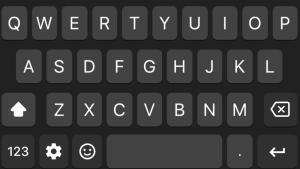Alphabet on the phone
The “alphabet on the phone” typically refers to how letters are assigned to the numerical keys on a mobile phone’s keypad or keyboard. This arrangement allows users to input text by pressing the appropriate keys, each representing a specific set of letters. This system was more common on older mobile phones with physical keypads. Here’s a detailed explanation of the typical arrangement:
Key 2 (ABC): The number 2 key is associated with the letters “A,” “B,” and “C.” To type “A,” you would press the 2 key once. To type “B,” you would press the 2 key twice quickly. To order “C,” you would press it three times.
Key 3 (DEF): The number 3 key is associated with the letters “D,” “E,” and “F,” following the same pattern as crucial 2. Press it once for “D,” twice for “E,” and three times for “F.”
Key 4 (GHI): The number 4 key is associated with the letters “G,” “H,” and “I,” with the same press-count pattern as keys 2 and 3.
Key 5 (JKL): The number 5 key is associated with the letters “J,” “K,” and “L.”
Key 6 (MNO): The number 6 key is associated with the letters “M,” “N,” and “O.”
Key 7 (PQRS): The number 7 key is associated with the letters “P,” “Q,” “R,” and “S.” To type “P,” you press 7 once; “Q” is pressed twice, “R” is pressed three times, and “S” is pressed four times.
Key 8 (TUV): The number 8 key is associated with the letters “T,” “U,” and “V.”
Key 9 (WXYZ): The number 9 key is associated with the letters “W,” “X,” “Y,” and “Z.” Like crucial 7, you cycle through these letters by pressing the key repeatedly.
Key 0 (Space/Special Characters): The number 0 key is often used for entering spaces between words or sometimes for accessing special characters and punctuation marks.
This alphabet arrangement allowed users to send text messages using a numeric keypad, with predictive text systems assisting in selecting the intended word based on key presses. However, with the prevalence of smartphones and touchscreen keyboards featuring the QWERTY layout, this numeric keypad text input method has become less common in recent years. Also, read about Light Bulb Security Camera
Evolution of Mobile Keyboards
From Physical Keyboards to Touchscreens
In the early days of mobile phones, physical keyboards dominated the landscape. However, the advent of touchscreen technology revolutionized the way we type on our phones.
Introduction of QWERTY Layout
The QWERTY keyboard layout, named after the first six letters on the top row, became the standard for mobile devices. Its design aimed to minimize typing errors and maximize efficiency.
Multilingual Support
Modern smartphones support multiple languages, allowing users to switch seamlessly between alphabets and scripts.
The ABCs of Mobile Typing
The On-Screen Keyboard
The on-screen keyboard is our primary tool for typing on smartphones. Its design has evolved to enhance user experience, with features like predictive text and auto-correction.
Voice-to-Text Technology
Voice recognition technology has come a long way, enabling users to dictate messages and search queries effortlessly.
Gesture Typing
Gesture typing, also known as swipe typing, lets users glide their fingers across the keyboard to form words quickly. This intuitive feature has become a favorite among smartphone users. Discover more about Effortless Ways to Minimize YouTube on iPhone
The Alphabet and Mobile Operating Systems
Android’s Alphabet Integration
Android, the world’s most popular mobile operating system, accommodates a wide range of languages and alphabets, making it accessible to a global audience.
iOS and the Alphabet
Apple’s iOS ecosystem ensures a seamless experience for users across the globe, with support for various languages and script systems.

Alphabet in Messaging and Social Media
Emojis and Emoticons
Emojis and emoticons have become a universal language, transcending alphabets to convey emotions and expressions.
Text Prediction and Auto-Correct
Modern keyboards use AI to predict text and correct mistakes, simplifying typing.
Multilingual Messaging
Messaging apps allow users to communicate in multiple languages effortlessly, promoting cross-cultural connections.
Alphabet in Search Engines
Voice Search and Assistant Technologies
Voice-activated assistants like Siri and Google Assistant understand and respond to spoken language, emphasizing the importance of the alphabet in voice search.
The Impact of Alphabet on SEO
SEO strategies must consider the alphabet’s role in search queries to ensure content reaches the right audience effectively.
Educational Apps and Alphabet Learning
Interactive Alphabet Games
Mobile apps make learning the alphabet engaging and interactive, benefiting children and adults alike.
E-Learning and Language Apps
Smartphones facilitate language learning with apps that offer lessons and practice exercises for various alphabets.
Alphabet and Cultural Diversity
Preserving Indigenous Languages
Smartphone apps and resources are instrumental in preserving endangered indigenous languages.
Globalization and Language Accessibility
Mobile technology fosters global communication and cultural exchange by breaking language barriers.

Conclusion
The alphabet’s integration into our smartphones has transformed how we communicate, learn, and connect with the world. As technology advances, the alphabet will remain at the core of our mobile experience.
FAQs
- How has the QWERTY layout influenced mobile typing?
The QWERTY layout was designed to minimize typing errors and maximize typing efficiency on physical keyboards. While it may not be the only layout used today, its influence on mobile typing is undeniable.
- Are voice-to-text technologies accurate on smartphones?
Yes, voice-to-text technologies have significantly improved accuracy over the years, thanks to AI and machine learning advancements.
- Can I learn a new alphabet using mobile apps?
Absolutely! There are numerous apps available that make learning new alphabets fun and interactive.
- How do emojis transcend language barriers?
Emojis convey emotions and expressions universally, allowing people from different linguistic backgrounds to understand each other better.
- What can we expect from the future of mobile typing?
The future promises even more intuitive and efficient ways of typing, with AI and augmented reality playing key roles.
